Interpretation of punctum inclinatum parvum
-
What is the difference in interpretation (meaning, performance) between the punctum inclinatum parvum (the small diamond-shaped notes) vs. the normal-sized punctum inclinatum? As in the final two notes of the second "lu" in the attached Alleluia (unfortunately, I cannot remember where I found this chant).
-
looks like the Introit for Christ the King. I think the small are simply a liquescent
-
Dixit_Dominus_44 is correct. It's a liquescent note. The Vatican edition uses two forms of the ancus: one that looks like a virga plus cephalicus, and one that looks like a climacus with two diminished pucta, but the interpretation is the same, and the liquescent is only voiced on the final note, even though both are printed smaller as a typographical convention.
-
looks like the Introit for Christ the King. I think the small are simply a liquescent
Both are right. The snippet is indeed from the introit Loquetur Dominus of the thirty-fourth week per annum. The alleluia however seems a neo-gregorian addition, so we can't compare with the notation in manuscripts.
I therefore looked for other examples, and found two in the offertory Vir erat of the twenty-seventh Sunday per annum (both on "eius"), and in the offertory Gressus meos of the thirty-second Sunday per annum (on "secundum"). The 1974 Graduale Romanum prints a punctum inclinatum parvum in these cases, while Anton Stingl for example transcribes the chant with a liquescent, which is apparent from the manuscript.
Here you can use the liquescent to transition from the vowel to the following consonant/vowel and then to the next syllable: secu-n-dum, e-i-us.
 Schermafbeelding 2021-04-13 om 00.48.16.png218 x 101 - 14K
Schermafbeelding 2021-04-13 om 00.48.16.png218 x 101 - 14K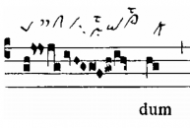
 Schermafbeelding 2021-04-13 om 00.48.31.png193 x 130 - 16K
Schermafbeelding 2021-04-13 om 00.48.31.png193 x 130 - 16K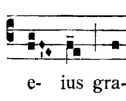
 Schermafbeelding 2021-04-13 om 00.52.21.png126 x 101 - 12K
Schermafbeelding 2021-04-13 om 00.52.21.png126 x 101 - 12K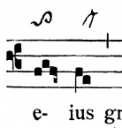
 Schermafbeelding 2021-04-13 om 00.52.10.png138 x 145 - 14K
Schermafbeelding 2021-04-13 om 00.52.10.png138 x 145 - 14K -
GR p.825 Modus Cantendi Alleluia TP mode IIIThanked by 1GregoryWeber
-
The lesson I'm taking away is that the second Alleluia is to be sung as five syllables, Al - le - lu - i - a, with the "i" on the second of the two "liquescent" notes, the first of which is liquescent only by typographical courtesy.
a_f_hawkins has found my source, "Modus Cantendi Alleluia", although I don't doubt that it is also found in the Introit for Christ the King.
Thanks to all for your advice! -
Al-le-lu-i-a in the Greek fashion is generally considered incorrect for Gregorian chant. The liquescent is more a combination of the u/w and i/j/y sounds in this case.
-
Which begs the question: what do folks do about the pronunciation of Alleluia in Taverner's Dum Transisset? I know it's specifically spelt out as Al - le - lu - i - a in some scores.Thanked by 1M. Jackson Osborn
-
The most recent Solesmes books (Antiphonale Romanum I & II for example) seem to use the liquescent only on the last note of a run of punctum inclinata. I was trying to find an example on an Alleluia, but haven't turned up an example yet. Here is an example from the antiphon Pater, manifestavi.
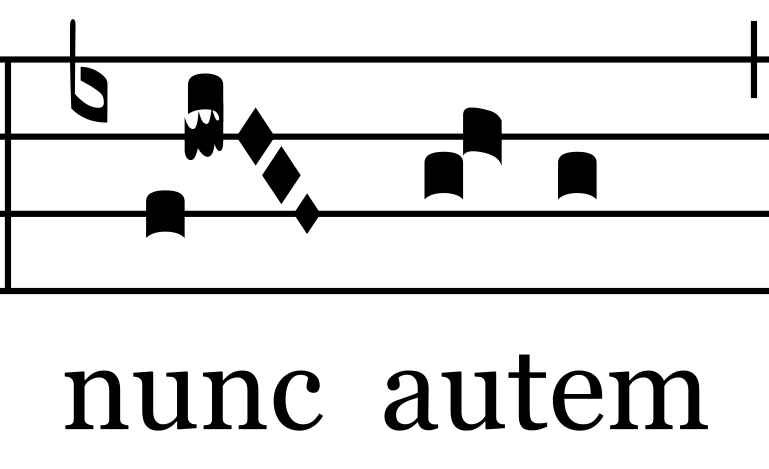
This would indicate that it is treated like a normal liquescent - whatever "normal" treatment is.
 Screenshot - nunc autem.png769 x 469 - 22K
Screenshot - nunc autem.png769 x 469 - 22K -
Casavant -
This was a peculiarity of English renaissance and early baroque syllabification. Taverner is not the only example. For another, look at Brrd's Sacerdotes Domini, where the correct rendition of the alleluyas is al - le - lu - i -a. More often than not this should be considered standard (whether it is or is not printed that way) for English polyphony of these periods. -
The great thing about liquescent neumes is that they make Gregorian chant scores so much more interesting. But they don't add anything useful to modern performance editions. Chanters should close syllables at the end of a neume. Or maybe not - depending on their performance practice. Such is determined by the text, not the melody.
Fr. Cardine categorizes them as "reminders".Thanked by 1GregoryWeber -
Which Renaissance scores are we looking at, specifically? For Dum transisent Burney (1782) gives "Al-le-lu-ja". In Gyffard and Dow I see the somewht equivocal "alleluy-a" and "allelui-a" but can't find instances with the first syllables hyphenated; Dow has a few cases of allelu-ia. Edit: the anonymous Viri Galilei on Gyffard fol. 141 ends with "Al le luy a" 's set to 4 neumes each.
The 1610 Gradualia print at IMSLP has Al-le-lu-ia, which still doesn't necessarily prove anything, but I'm skeptical in light of Peter Philip's consistent use of al-le-lu-ya. Rigg's chapter on Anglo-Latin in Singing Early Music unfortunately doesn't touch on Ал-ли-луй-и-а, which one would think a curious omission if it had been a standard pronunciation.Thanked by 1M. Jackson Osborn -
With regard to the antiphon Pater manifestavi, the small punctum inclinatum is indeed treated as a liquescent, as can be seen from the manuscript.
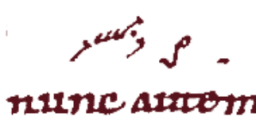
 Schermafbeelding 2021-04-14 om 14.16.04.png340 x 161 - 28K
Schermafbeelding 2021-04-14 om 14.16.04.png340 x 161 - 28K -
madorganist: "The liquescent is more a combination of the u/w and i/j/y sounds in this case."
I am trying to imagine how to pronounce that, and I am even trying to actually pronounce that, but have no idea if I'm succeeding. -
all-leh-loo-wyahI am trying to imagine how to pronounce that, and I am even trying to actually pronounce that, but have no idea if I'm succeeding.
I cannot say loo-yah in a way that would be intelligible without a slight puckering of the lips (beyond what is necessary for the oo sound) between the two syllables, which I've represented as a /w/ phoneme. Going back to the Byzantine pronunciation, I don't think al-le-lu-i-a is possible either without that sound between the vowels ui. That's the sound that's vocalized on the liquescent note. As others have said, it's more of a reminder of good diction than anything else.
Welcome to the MusicaSacra Forum!
To participate in the discussions on Catholic church music, sign in or register as a forum member, The forum is a project of the Church Music Association of America.
Categories
- All Discussions21,154
- General Music Discussion8,235
- Job Openings204
- Management of Music Programs850
- Choral Matters533
- Church Documents and Rubrics526
- CMAA Notes303
- Events719
- For Newcomers: Read First26
- Sacred Polyphony547
- Hymnody872
- Gregorian Chant: General2,702
- ↳ Graduale Romanum and Liber Usualis368
- ↳ Graduale Simplex60
- ↳ Semiology63
- Vernacular Plainsong696
- Anglican Use and Anglican Chant68
- Organ, Other Instruments and Repertoire435
- New Composition/Works in Progress1,295
- Recordings234
- Music for Hispanic Ministry159
- Music Education: Children211
- Music Education: General222
- News Items245
- Positions Wanted2
- General Discussion: Catholicism739
- Amusements177
- General Discussion1,035
- Opinions119


